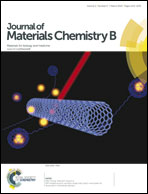Bioactive tantalum metal prepared by micro-arc oxidation and NaOH treatment
Abstract
The study aim was to evaluate the effect of micro-arc oxidation (MAO) and alkali treatment on porous tantalum specimens by foam immersion technology. Tantalum specimens modified by MAO formed an apatite layer on their surfaces in simulated body fluid (SBF). However, the leach liquor of these specimens shows toxicity to 3T3-E1 cells. When they were previously soaked in a 0.5 M NaOH aqueous solution at 60 °C for 24 h, there was no statistical difference between the leach liquor of specimens with NaOH pretreatment and the control in cell proliferation experiments. NaOH-treated tantalum metal can form more apatite on its surface in SBF than the control and specimens produced by MAO. Furthermore, a sodium tantalate hydrogel layer was observed on the specimen's surface by X-ray diffraction. Well defined actin stress fibers and bone-like tissue are distributed throughout the body of 3T3-E1 cells cultured on specimens after 5 days. Animal tests showed new bone formation in the gap between the specimens and the host bone after 4 weeks. Neovascularization and new bone ingrowth occurred within the pores of the specimens after 4 and 12 weeks, respectively. Our results indicated that highly bioactive tantalum metal can be obtained by simple chemical treatment.


 Please wait while we load your content...
Please wait while we load your content...